Growth performance of affluent Indian children is similar to that in developed countries
Nita Bhandari,1 Rajiv Bahl,1 Sunita Taneja,1 Mercedes de Onis,2 & Maharaj K. Bhan3
OBJECTIVE: A cross-sectional survey was conducted in order to determine whether an affluent population in south Delhi had a growth performance similar to that in developed countries and to identify socioeconomic factors that militated against optimal growth in this group.
METHODS: The weights and lengths of 395 children aged 1223 months and the heights of 331 mothers and 153 grandmothers were measured and information was obtained on family socioeconomic status and child-feeding practices. Children born prematurely, i.e. before 37 weeks of gestation, and those with illness adversely affecting growth, were excluded from the analysis, as with the NCHS/WHO reference population.
RESULTS: In 341 children included in the analysis, the mean Z-scores for weight-for-age, length-for-age and weight-for-length were 0.45, 0.28 and 0.32 respectively. About 6% of the children were underweight (weight-for-age Z-score £2), 3% were stunted (length-for-age Z-score £2), and 4% were wasted (weight-for-length Z-score £2). The factors that were significantly associated with higher length-for-age were one or both parents having 17 years or more of education (mean length-for-age Z-score 0.17) and non-vegetarian diet (mean length-for-age Z-score 0.18). No socioeconomic factors were associated with mean weight-for-length.
CONCLUSION: The children in this affluent population were close to the NCHS/WHO reference population with regard to anthropometric indicators. The subpopulation with higher parental education had even better growth. It is intended to include this subpopulation in the WHO Multicentre Growth Reference Study.
Keywords Growth; Body weight; Body height; Socioeconomic factors; Breast feeding; Cross- sectional studies (source: MeSH, NLM).
Mots clés Croissance; Poids corporel; Taille corporelle; Facteur socio-économique; Allaitement au sein; Etude section efficace (source: MeSH, INSERM).
Palabras clave Crecimiento; Peso corporal; Estatura; Factores socioeconómicos; Lactancia materna; Estudios transversales (fuente: DeCS, BIREME).
Introduction
There is evidence that growth patterns of well-fed healthy preschool children from diverse ethnic backgrounds are similar (13). Some variability exists between affluent populations in different countries but they are relatively small compared with the worldwide variation in growth related to health and nutrition (4). This suggests the possibility that even in developing countries there are subpopulations with no environmental constraints on growth, and indeed there have been reports to this effect (59). We conducted a cross-sectional survey in order to determine whether an affluent population in south Delhi had a growth performance similar to that in developed countries and to identify the socioeconomic factors hindering optimal growth in this group. Furthermore, WHO wished to assess whether Delhi would be suitable as a participating site in the Multicentre Growth Reference Study (MGRS). MGRS is an international effort coordinated by WHO with the aim of developing a new reference for assessing the growth and nutritional status of infants and young children (10). Unlike the current National Center for Health Statistics (NCHS)/WHO reference, the new one is intended to be based on an international sample of breastfed infants in healthy populations without socioeconomic constraints on growth (11). This should ensure that the new curves reflect the true growth potential of children, unaffected by maternal nutrition, the quality of complementary foods, or other social or environmental factors (12).
Materials and methods
The survey was conducted in south Delhi, one of the most affluent sections in the city. Of the 133 neighbourhoods in this area, 75 were excluded because they were slum clusters, institutional residential areas, hostels or unauthorized low-income group housing schemes, or had low land rates as published by government agencies (13, 14).
The selected neighbourhoods comprised either houses of the bungalow type (43 neighbourhoods), i.e. independent units with gardens and therefore expected to be comparatively affluent, or apartment-type houses or condominiums (15 neighbourhoods). Fifteen randomly selected bungalow-type neighbourhoods and all the apartment-type neighbourhoods were surveyed.
After enumeration of all the blocks in each neighbourhood, one block was randomly chosen and introductory letters were delivered to the first 500 house numbers. These households were surveyed until a minimum of 15 children aged 1223 months were identified; if this number was not available the next block was also surveyed.
Identification of eligible children and data collection
In each household the members of the surveying team (a physician, a nutritionist and two anthropometrists) introduced themselves, explained the purpose of the study and asked whether a child aged 1223 months was resident. If more than one child was present, i.e. sharing the same kitchen, the youngest was selected. After consent was obtained an interview was conducted with the mother. The child's weight and length, and the weights and heights of the mother and grandmothers, were measured. The weight measurements were corrected for the weight of clothing.
The interview questionnaire covered the parents' education, occupations, income, assets, birth weight, feeding practices and morbidity. If a family was unavailable initially, three visits were made during the next two weeks with a view to making contact. Failing this, no further attempt to contact the family was made.
Training and standardization
The correct techniques for measuring weight by the taring method on UNICEF solar scales (accurate to 100 g) and the supine length of children by means of locally manufactured infantometers (accurate to 0.1 cm) were demonstrated to the field workers.
A technical error of measurement (TEM) was estimated for each anthropometrist by measuring the lengths and weights of a set of 10 children. The anthropometrists and the supervisor measured the length of each child in succession (reading 1). Serial second measurements of length were then obtained (reading 2). The TEM for each person was calculated by a standard program developed in FoxPro using the formula  (reading 1 reading 2)2/2n, where n is the number of children measured.
(reading 1 reading 2)2/2n, where n is the number of children measured.
Similar procedures were used to standardize weight measurements. Training continued until the anthropometrists achieved TEM values below 2.5 mm for length and 0.1 kg for weight. Such values represent a very high level of standardization between workers (12). The weighing scales were calibrated daily against known weights of 5 kg and 10 kg. Infantometers were calibrated using rods of standard length.
Data management and analysis
After manual checks the questionnaires were entered independently by two data-entry clerks using FoxPro for Windows software (version 2.6). The entries were validated and corrections were made within 48 hours. Range and logical checks were inbuilt.
The main objective of the study was to make anthropometric comparisons between children aged 1223 months in the selected population and children of the same age group in the NCHS/WHO reference population. When selecting children for analysis, therefore, we used exclusion criteria that were similar to those used in the Fels study population, which comprised the NCHS growth reference for children aged 02 years, and did not include premature children and those with factors significantly delaying growth (2, 15). We therefore excluded premature children, those with under 37 weeks of gestation, and children with chronic illnesses known to adversely affect growth.
Z-scores were calculated using the EPI NUT program (WHO/Centers for Disease Control and Prevention). We used the mean Z-scores, rather than the proportion of children with a score below 2Z, for comparison of the study population with the NCHS/WHO reference population and for the identification of socioeconomic factors related to better anthropometric status. These scores had the advantage of describing the anthropometric status of the entire population, without resorting to a subset of individuals below a set cut-off (2). For any given sample size the precision of the estimate is greater for the mean Z-score than for the proportion below 2Z. The mean Z-score can also be used to estimate the expected proportions below 2Z; mean Z-scores of 0.5, 0.3 and 0 translate into prevalences of 6.7%, 4.5% and 2.3% respectively (2).
The analysis was performed by means of Epi Info (version 6) and STATA (6.0). The c2 test was applied to categorical variables. Continuous variables were tested by means of ANOVA. The significance level was fixed at P
Results
Children included in analysis
From the 18 879 households surveyed, 521 children (2.7%) aged 1223 months were identified. It was possible to interview 395 of the families (75.8%); 71 families were unavailable (13.6%) and 55 refused to participate (10.5%). Fifty-four children were excluded (13.7%) because of prematurity, chronic illness affecting growth, or both (Fig. 1).
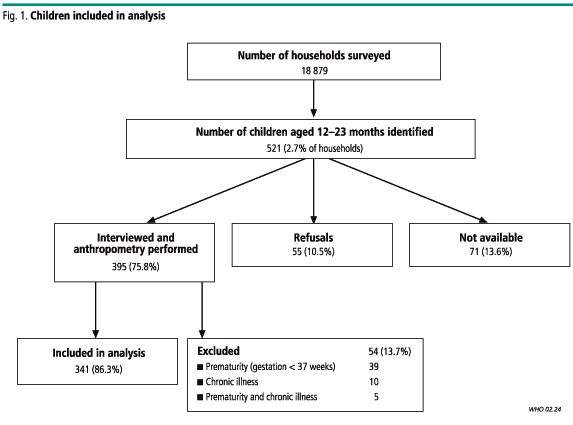
Socioeconomic characteristics
About two-thirds of the children lived in extended families and the majority of mothers were North Indians. Almost all the mothers had completed 12 years of schooling; slightly fewer than half had completed at least 17 years of education (school and university). All the fathers had completed their schooling, and half had completed at least 17 years of education. Over two-thirds of the families owned their places of residence. In 15% of the families the total income, computed by adding the earned incomes of all family members and property rentals, was less than Rs 15 000 (US$ 350) a month. About 40% of the families had monthly household incomes between Rs 15 000 and Rs 30 000 and the same percentage had monthly incomes greater than Rs 30 000 ($700). Six families (1.8%) did not disclose their incomes (Table 1).
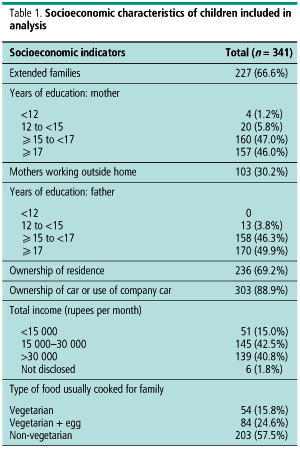
Delivery practices
All the included children were born in hospitals. About 14% of the mothers delivered outside the city of Delhi. Eighty per cent of deliveries occurred in 46 hospitals and nursing homes; some of these facilities were outside south Delhi. Forty per cent of infants were delivered by caesarean section.
Following delivery, 108 infants were admitted to nursery for routine care and were taken to the mothers at intervals for breastfeeding in accordance with usual practice in several nursing homes in Delhi. Fifty infants were admitted to nursery for illness; the duration of nursery stay was less than 24 hours for six infants, 2448 hours for 10 and more than 48 hours for 34 infants.
Feeding practices
Breastfeeding was initiated in 60.8% of the infants within 12 hours of birth; in 17.4% it began when they were more than 24 hours of age (Table 2). Only 24.6% of the infants were exclusively breastfed up to the age of four months; an additional 12.9% were predominantly breastfed up to this age and also received other fluids, e.g. water, water-based drinks, fruit juice and oral rehydration salts solution. Almost two- thirds of mothers stopped breastfeeding before their infants were 1 year of age.
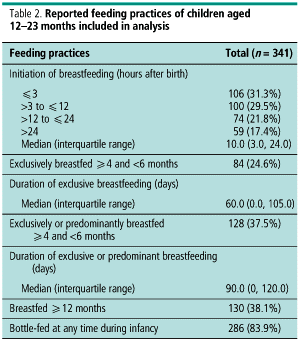
Animal or formula milk was introduced at a mean age of 3 months. Animal milk was fed to 83.5% of the infants and formula milk to 62.5%. Eggs were fed to 57% of the infants during the first year of life. Non-vegetarian foods (boiled shredded chicken, fish, or meat or chicken soups) were used by only 2.4% of families for infants during the first year of life, even though 57.5% of parents were not vegetarians. Over three-quarters of children aged 1 year were consuming all family foods.
Heights of mothers and grandmothers
The mean heights of mothers and grandmothers were 156.4 cm and 151.3 cm respectively, with standard deviations of 5.7 cm and 5.8 cm.
Anthropometric status of children
The mean reported birth weight was 3110 g. The mean of birth weights verified from the birth records of about 60% of the children was 3120 g (Table 3). The mean birth length calculated from birth records for about a third of the children was 49.5 cm.
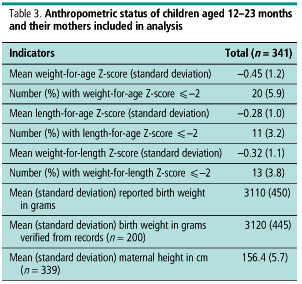
The anthropometric status of the children in the study was close to that of the NCHS/WHO reference population. The mean weight-for-age, length-for-age and weight-for-length Z-scores were 0.45, 0.28 and 0.32 respectively. About 6% were underweight, 3% were stunted , and 4% were wasted, as indicated by weight-for-age, length-for-age and weight-for-length Z-scores of 2 or less (Table 3).
In the subgroup of 54 children excluded from analysis (Fig. 1), the mean weight-for-age, weight-for-length and length-for-age Z-scores were 0.89, 0.35 and 0.57 respectively. The mean maternal height in this group was similar to that of mothers of children included in the analysis, but the mean birth weight was lower (2520 g versus 3110 g). This indicated that the excluded children were not different in their genetic growth potential but that their growth was adversely affected by postconceptional or postdelivery factors.
The socioeconomic factors that were significantly associated with higher mean length-for-age were 17 years or more of parental education (mean length-for-age Z-score 0.17) and a non-vegetarian diet (mean length-for-age Z-score 0.18) (Table 4). Maternal education of 17 years or more and non-vegetarian family diets continued to be significantly associated with higher length-for-age Z-scores in a multiple linear regression model following adjustment for potential confounding factors including age, sex, birth weight and other socioeconomic characteristics, e.g. family income, mother's working status, type of neighbourhood, and paternal education (Table 5).
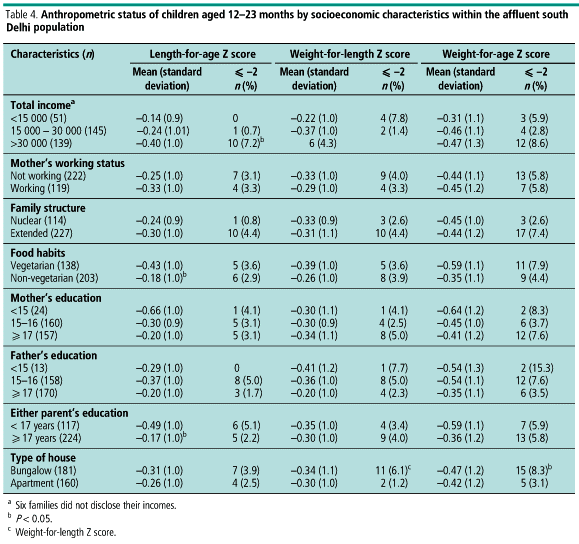

The prevalence of wasting was significantly lower among children who were from apartment-type houses. This difference, however, became non-significant after adjustment for potential confounders in a logistic regression model (data not shown).
Discussion
The mean Z-scores for the three anthropometric indicators for the children in the affluent south Delhi population ranged from 0.28 to 0.45, with a standard deviation of about 1. These values showed that the study population was close to the NCHS/WHO reference population. In MGRS, sample size has been estimated to detect differences in means of 0.4 Z-scores between study sites. This magnitude of difference was decided on the basis of current knowledge of the effect of progressively worsening socioeconomic status or chance in mean Z-scores (12).
The mean Z-scores of children in the study were markedly higher than those of children aged 1223 months residing in urban slums in the south Delhi area. In a recently concluded study the mean length-for-age, weight-for-age and weight-for-length Z-scores were 1.95, 2.2 and 1.47 respectively (MK Bhan, personal communication, 2001).
These results are consistent with previous reports that the anthropometric status of children of the upper socioeconomic class was similar to the NCHS/WHO reference in at least two of seven Indian cities surveyed (5, 6). Several studies have shown that dietary and environmental constraints are the major determinants of differences in growth performance between children of developing and developed countries (79, 1620). The findings of the present study add to the evidence that makes a strong case for a single global reference based on a pooled sample of children from diverse ethnic backgrounds (21).
We attempted to determine if there were any socioeconomic factors associated with better nutritional status even within the affluent population studied. Higher maternal education and non-vegetarian food habits were associated with better length-for-age status but no socioeconomic factor was associated with weight-for-length. This suggests that, in addition to income, literacy and food quality may be important factors affecting linear growth, while high income may be enough to achieve ponderal growth.
Higher parental education has consistently been shown to be associated with better linear as well as ponderal growth during infancy and childhood in various socioeconomic settings (2224). Evidence of an association between family income and growth has been less consistent: some studies have shown a clear association (25, 26) whereas others have shown none (27). In our study, increasing income was not associated with better weight-for-length or length-for-age status, possibly because the variability in incomes was low or because reporting was unreliable.
The standard deviations of the mean length-for-age, weight-for-age and weight-for-length Z-scores were remarkably consistent and close to the expected value of 1.0 for the reference population, indicating that the quality of the data in the present survey was high (2).
Whereas the heights of the children in the present study were comparable with those of the NCHS/WHO reference, those of the mothers and grandmothers were not. The data from south Delhi seem to indicate an ongoing secular trend in women's height. Almost all mothers of included children but only 46% of grandmothers were available for anthropometry. We therefore cannot rule out the possibility that the grandmothers who were unavailable were taller than those who were available, as we did not ascertain the reasons for non-residence with the enrolled children.
The populations of several developed countries can generally be considered to have achieved their full genetic growth potential and a random sample of these populations can, therefore, be included for constructing a growth reference. However, this is not yet the case for populations of most developing countries. The children belonging to the subpopulation of affluent families residing in south Delhi with high parental education (i.e. at least one parent with 17 years or more of education) appear to have achieved their genetic growth potential. This population will be included in MGRS for the construction of a new growth reference for the world's children. 
Acknowledgements
We are grateful to the Department of Nutrition for Health and Development, World Health Organization, Geneva, for funding this study. We are also grateful for the support of the Norwegian Universities' Committee for Development and Research and the Indian Council of Medical Research, and for the assistance of Ms Baljeet Kaur with the statistical analysis.
Conflicts of interest: none declared.
Résumé
Les enfants indiens de familles aisées ont des caractéristiques de croissance similaires à celles des enfants des pays développés
OBJECTIF: Une enquête transversale a été réalisée afin de déterminer si dans une population aisée du sud de Delhi, les enfants ont des caractéristiques de croissance similaires à celles des enfants des pays développés et d'identifier les facteurs socio-économiques qui pourraient être défavorables à la croissance dans ce groupe.
MÉTHODES: Lors de l'enquête, on a mesuré le poids et la taille de 395 enfants de 12 à 23 mois et la taille de 331 mères et 153 grands-mères et on a recueilli des informations sur la situation socio-économique de la famille et sur les pratiques concernant l'alimentation des enfants. Les enfants nés prématurés, c'est-à-dire avant 37 semaines de grossesse, et ceux qui étaient atteints de maladies empêchant une croissance optimale, ont été exclus de l'analyse, comme il a été fait dans la population de référence NCHS/OMS.
RÉSULTATS: Chez les 341 enfants inclus dans l'analyse, la valeur moyennne du Z pour les rapports poids/âge, taille/âge et poids/taille était respectivement de 0,45, 0,28 et 0,32. Environ 6 % des enfants présentaient un poids insuffisant (Z du rapport poids/âge £ 2), 3 % présentaient un retard de croissance (Z du rapport taille/âge £ 2), et 4 % étaient émaciés (Z du rapport poids/taille £ 2). Les facteurs significativement associés avec une valeur plus élevée du rapport taille/âge étaient une durée des études égale ou supérieure à 17 ans pour un ou les deux parents (valeur moyenne du Z pour le rapport taille/âge 0,17) et un régime alimentaire non végétarien (valeur moyenne du Z pour le rapport taille/âge 0,18). Aucun facteur socio-économique n'était associé au rapport poids/taille moyen.
CONCLUSION: Les enfants de cette population aisée étaient proches de la population de référence NCHS/OMS en ce qui concerne les indicateurs anthropométriques. La sous-population issue de parents ayant fait des études plus longues avait des caractéristiques de croissance encore meilleures. Il est prévu d'inclure cette sous-population dans l'étude multicentrique OMS sur les valeurs de référence pour la croissance.
Resumen
El crecimiento de niños indios de familias prósperas, similar al de los países desarrollados
OBJETIVO: Se realizó un estudio transversal para determinar si los niños de una población próspera del sur de Delhi presentaban un crecimiento similar a los de los países desarrollados, así como para identificar los factores socioeconómicos que se oponían a un crecimiento óptimo en ese grupo.
MÉTODOS: Se midieron el peso y la estatura de 395 niños de 12 a 23 meses, así como la estatura de 331 madres y 153 abuelas, y se obtuvo información sobre el nivel socioeconómico de las familias y las prácticas de alimentación de los niños. Se excluyó del análisis a los niños nacidos prematuramente (antes de las 37 semanas de gestación) así como a los afectados por enfermedades que inhiben el crecimiento, al igual que ocurre con la población de referencia NCHS/OMS.
RESULTADOS: Entre los 341 niños incluidos en el análisis, las puntuaciones Z medias correspondientes al peso para la edad, la talla para la edad y el peso para la talla fueron de 0,45, 0,28 y 0,32, respectivamente. En torno a un 6% de los niños pesaban menos de lo normal (Z del peso para la edad £ 2), el 3% sufría retraso del crecimiento (Z de la talla para la edad £ 2), y el 4% presentaba emaciación (Z del peso para la talla £ 2). Los factores significativamente asociados a una mayor talla para la edad fueron el hecho de que al menos uno de los progenitores hubiese disfrutado de 17 años o más de educación (Z de la talla media para la edad 0,17) y el seguimiento de una dieta no vegetariana (Z de la talla media para la edad 0,18). No se observó ninguna relación entre cualquiera de los factores socioeconómicos considerados y el peso medio para la talla.
CONCLUSIÓN: Los niños de esta población próspera eran de características similares a los de la población de referencia NCHS/OMS en lo que respecta a los indicadores antropométricos. La subpoblación con mayor grado de instrucción de los padres presentó un crecimiento incluso mejor. Se tiene la intención de incluir a esa subpoblación en el Estudio Multicéntrico de la OMS sobre el Patrón de Crecimiento.
References
1. Habicht JP, Martorell R, Yarbrough C, Malina RM, Klein RE. Height and weight standards for preschool children: how relevant are ethnic differences in growth potential? Lancet 1974;1:611-5.
2. World Health Organization. Physical status: the use and interpretation of anthropometry. Report of a WHO Expert Committee. Geneva: World Health Organization; 1995. WHO Technical Report Series, No. 854.
3. WHO Working Group on the Growth Reference Protocol and WHO Task Force on Methods for the Natural Regulation of Fertility. Growth patterns of breastfed infants in seven countries. Acta Paediatrica 2000;89:215-22.
4. de Onis M, Blössner M. WHO global database on child growth and malnutrition. Geneva: World Health Organization; 1997. Unpublished document WHO/NUT/97.4.
5. Agarwal DK, Agarwal KN. Physical growth in Indian affluent children (birth-6 years). Indian Pediatrics 1994;31:377-413.
6. Agarwal KN, Agarwal DK, Benkappa DG, Gupta PC, Khatua SP, et al. Growth performance of affluent Indian children (under fives). New Delhi: Nutrition Foundation of India; 1991. Scientific Report No. 11.
7. Droomers M, Gross R, Schultink W, Sastroamidjojo S, et al. High socioeconomic class preschool children from Jakarta, Indonesia are taller and heavier than NCHS reference population. European Journal of Clinical Nutrition 1995; 49:740-4.
8. Serenius F. Attained growth of privileged Saudi children during the first three years of life. Acta Pediatrica Scandinavica 1988;346Suppl.:80-92.
9. Quinn VJ, Chiligo-Mpoma MO, Simler K, Milner J. The growth of Malawian preschool children from different socioeconomic groups. European Journal of Clinical Nutrition 1995;49:66-72.
10. de Onis M, Garza C, Habicht JP. Time for a new growth reference. Pediatrics 1997;100 (5):E8. Available from: URL: http://www.pediatrics.org/cgi/content/full/100/5/e8
11. de Onis M, Habicht JP. Anthropometric reference data for international use: recommendations from a World Health Organization Expert Committee. American Journal of Clinical Nutrition 1996;64:650-8.
12. World Health Organization. WHO Multicentre Growth Reference Study Protocol. Geneva: World Health Organization; 1997.
13. Delhi Development Authority. Order No. F.R. 116/7/82 L&B/3026-34 dated 31.1.1992.
14. Ministry of Urban Development (Lands Division), Government of India. Letter No. J-220 11/1/91-LD.
15. Hamill PV, Drizd TA, Johnson CL, Reed RB, Roche AF, Moore WM. Physical growth: National Center for Health Statistics percentiles. American Journal of Clinical Nutrition 1979;32:607-29.
16. Graitcer PL, Gentry EM. Measuring children: one reference for all. Lancet 1981;2:297-9.
17. Mei Z, Yip R, Trowbridge F. Improving trend of growth of Asian refugee children in the USA: evidence to support the importance of environmental factors on growth. Asia Pacific Journal of Clinical Nutrition 1998;7:111-6.
18. Dugdale AE, Muller M, Alsop-Shields L. Patterns of weight growth in Aboriginal children on Queensland communities. Journal of Pediatrics and Child Health 1994;30:55-8.
19. Bhasin SK, Singh S, Kapil U, Sood VP, Gaur DR. Height and weight of well-to-do school children in Haryana. Indian Pediatrics 1990;27:1089-93.
20. Loka P, Nossar V, Bauman AE. A comparative study of the growth of South-East Asian children in south-west Sydney born in Australia and overseas. Journal of Pediatrics and Child Health 1994;30:436-8.
21. Garza C, de Onis M. A new international growth reference for young children. American Journal of Clinical Nutrition 1999;70(1):169S-72S.
22. de Souza AC, Peterson KE, Cufino E, Gardner J, Craveiro MV, Ascherio A. Relationship between health services, socioeconomic variables and inadequate weight gain among Brazilian children. Bulletin of the World Health Organization 1999;77(11):895-905.
23. Bobak M, Kriz B, Leon DA, Danova J, Marmot M. Socioeconomic factors and height of preschool children in the Czech Republic. American Journal of Public Health 1994;84(7):1167-70.
24. Lartey A, Manu A, Brown KH, Peerson JM, Dewey KG. Predictors of growth from 1 to 18 months among breast fed Ghanaian infants. European Journal of Clinical Nutrition 2000;54(1):41-9.
25. Ahmed F, Bhuyan MA, Shaheen N, Barua S, Margetts BM, Jackson AA. Effect of socio-demographic conditions on growth of urban school children of Bangladesh. European Journal of Clinical Nutrition 1991;45(6):327-30.
26. Christiansen N, Mora JO, Herrera MG. Family social characteristics related to physical growth of young children. British Journal of Preventive and Social Medicine 1975;29(2):121-30.
27. Baxter-Jones AD, Cardy AH, Helms PJ, Phillips DO, Smith WC. Influence of socioeconomic conditions on growth in infancy: the 1921 Aberdeen birth cohort. Archives of Disease in Childhood 1999;81(1):5-9.
1 Scientist, Centre for Diarrhoeal Disease and Nutrition, Department of Paediatrics, All India Institute of Medical Sciences, Ansari Nagar, New Delhi 110029, India (email: community.research@cih.uib.no). Correspondence should be addressed to Dr Bhandari at this address.
2 Medical Officer, Department of Nutrition for Health and Development, World Health Organization, Geneva, Switzerland.
3 Professor, Department of Paediatrics, All India Institute of Medical Sciences, New Delhi, India.
Ref. No. 01-1139
